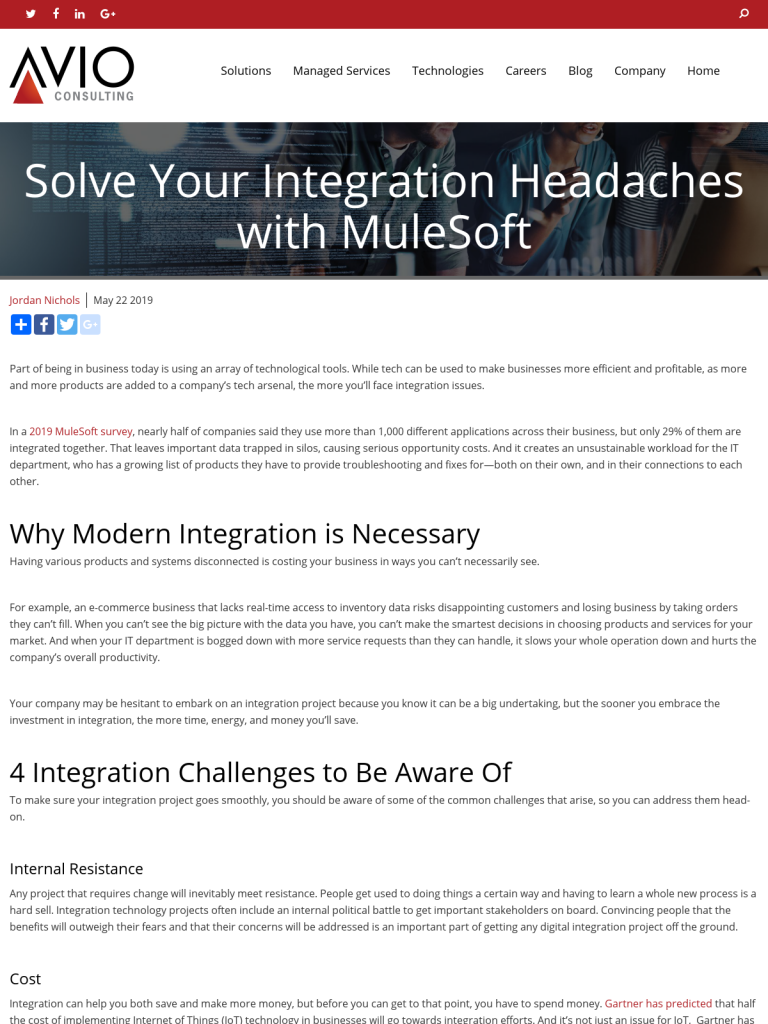Solve Your Integration Headaches with MuleSoft
Blog: BPM Blog Avio Consulting

Part of being in business today is using an array of technological tools. While tech can be used to make businesses more efficient and profitable, as more and more products are added to a company’s tech arsenal, the more you’ll face integration issues.
In a 2019 MuleSoft survey, nearly half of companies said they use more than 1,000 different applications across their business, but only 29% of them are integrated together. That leaves important data trapped in silos, causing serious opportunity costs. And it creates an unsustainable workload for the IT department, who has a growing list of products they have to provide troubleshooting and fixes for—both on their own, and in their connections to each other.
Why Modern Integration is Necessary
Having various products and systems disconnected is costing your business in ways you can’t necessarily see.
For example, an e-commerce business that lacks real-time access to inventory data risks disappointing customers and losing business by taking orders they can’t fill. When you can’t see the big picture with the data you have, you can’t make the smartest decisions in choosing products and services for your market. And when your IT department is bogged down with more service requests than they can handle, it slows your whole operation down and hurts the company’s overall productivity.
Your company may be hesitant to embark on an integration project because you know it can be a big undertaking, but the sooner you embrace the investment in integration, the more time, energy, and money you’ll save.
4 Integration Challenges to Be Aware Of
To make sure your integration project goes smoothly, you should be aware of some of the common challenges that arise, so you can address them head-on.
Internal Resistance
Any project that requires change will inevitably meet resistance. People get used to doing things a certain way and having to learn a whole new process is a hard sell. Integration technology projects often include an internal political battle to get important stakeholders on board. Convincing people that the benefits will outweigh their fears and that their concerns will be addressed is an important part of getting any digital integration project off the ground.
Cost
Integration can help you both save and make more money, but before you can get to that point, you have to spend money. Gartner has predicted that half the cost of implementing Internet of Things (IoT) technology in businesses will go towards integration efforts. And it’s not just an issue for IoT, Gartner has also predicted that through 2020, half of the time and cost involved in building a digital platform for businesses will be for integration. Any integration efforts your company takes on will require having an adequate budget, but the cost shouldn’t stop you from taking the plunge.
Complexity
The more disconnected apps your company depends on, the bigger a challenge it will be to get them all working together seamlessly in the future. Most businesses are moving towards having more tech products they rely on, rather than less. Without the right integration solution, compatibility issues will only get more complicated and unsustainable. But if you approach integration with an eye toward the long term, you can ensure you build a system that makes adding future apps to your company’s processes easier.
Security
Security is too important to treat as an afterthought. Choosing the wrong integration tool can potentially increase your risk to security threats. 70% of organizations said that their integration tool increased data security and compliance risks. With the right approach, you can achieve integration without creating new security risks.
How to Overcome Common Integration Challenges
When you know what difficulties to be aware of in advance, you can start your integration project more prepared to address them head-on. With extensive experience working on tech integration projects, AVIO has adopted some best practices for making sure integration solves a company’s primary tech problems, without adding new ones to deal with.
Start with the business problem.
Every business is different, there’s no one-size-fits-all integration solution. Before you can develop the right integration strategy, you need to clarify the specific problems you want it to solve.
Pick the right integration technology.
As with any problem, you need the right tool to solve it. We have experience guiding clients through MuleSoft integration projects, so you know the product offers powerful features that help solve many common integration challenges.
Develop a long-term strategy.
You don’t just need a solution for right now, you need one that will continue to make tech compatibility issues manageable well into the future. Getting it right requires thinking long term in your plan.
Make a security plan part of your strategy.
Security needs to be a top priority in the strategy you develop. Before you start the integration process, you should establish the foundation for all integrations, which includes defining the different levels of security and access involved in each product and connection.
Use skilled consultants to reduce your risk.
Your employees are busy and don’t want their other work disrupted by the project. By bringing in outside consultants who know how to start your MuleSoft integration off on the right foot and get the momentum going, you can reduce the impact it has on other internal projects and deadlines.
Finding the Right Partner For Your MuleSoft Strategy
Hiring skilled consultants can help, but what’s even better is finding a partner in the process. You want a company that understands MuleSoft, is familiar with the elements of a successful integration process, and just as importantly, knows how to center your particular needs and circumstances.
AVIO has proven experience with MuleSoft integration. We’ve helped clients integrate their tech and improve their processes through our unique approach. For one client, our guidance leads to 98% faster order processing times and complete elimination of order errors. Whatever your integration problems are, we can help you solve them.
Leave a Comment
You must be logged in to post a comment.









Join the Conversation